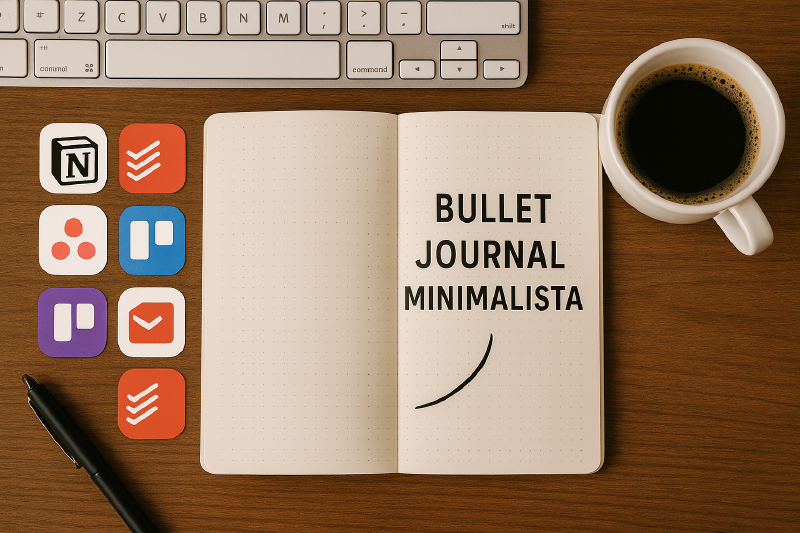A year ago, if someone had told me I’d abandon my countless time-management apps for a simple paper notebook, I’d have looked at them like they’d lost their mind. I’m a software developer—I live surrounded by screens—and my need (and obsession) to optimize every minute led me to try dozens of apps for this purpose: Trello, Notion, Todoist, TickTick, Apple Reminders, Asana… even Obsidian with custom plugins. But today, my organizational tool fits in a simple A5 notebook and doesn’t need batteries.
This has been my journey toward a minimalist Bullet Journal.
Digital Failure: When More Apps = More Chaos
For years, I believed the answer to my disorganization lay in the next all-in-one app. Instead, I ended up with constant notifications, forgotten or perpetually postponed reminders, and relentless anxiety about keeping everything logged in the “right” app.
Paradoxically, digital tools distracted me more than they helped. The overload of options and the false sense of control (so many graphs! so many labels! so many view modes!) constantly pulled me away from focus.
The Discovery: Ryder Carroll and Radical Simplicity
I stumbled upon a curious method called the Bullet Journal by pure chance. Intrigued, I researched the original system by Ryder Carroll, even bought his book The Bullet Journal Method to dive deeper… and something clicked. It was an analog, flexible, action-centered system—not about decorations or frills.
I bought a simple dotted notebook, a black ink pen (comfortable enough), and started with the basics: Index, Future Log, Monthly Log, and Daily Log. My initial goal was to test whether this method lived up to its revolutionary promises and see if I could adapt to this new workflow, given my digital past.
Why Analog Works (When Digital Fails)
After weeks of using my BuJo, I noticed its key advantages:
- Fewer Distractions, More Focus: No notifications, no temptation to open social media after checking a task. Writing by hand forces me to think before jotting, filtering out trivialities.
- Unlimited Flexibility: A grocery list next to a project flowchart? Digitally, that would require three apps. In my BuJo, it’s two adjacent pages.
- Physical Memory: Crossing out a completed task with a quick swipe (the iconic X instead of a checkbox!) creates tangible satisfaction no digital checkmark can match.
- Privacy and Ownership: My data isn’t in someone else’s cloud. It’s my system—no algorithms, subscriptions, or updates disrupting my flow. Plus, easily storable for years of future reference.
Another major advantage for me: everything lives in one notebook—personal, family, work, commitments. This centralizes my productivity focus, eliminating the fear of overlooking tasks scattered across apps.
My Style: Pure Minimalism (No Washi Tapes, Stickers, or Watercolors)
On Instagram or Pinterest, Bullet Journals are often associated with colorful designs, ornamental calligraphy, and themed pages. It feels like style trumps substance. For me, that’s counterproductive. My rule is clear: if it doesn’t add functionality, it’s out. I use only:
- Bold headers with a slightly thicker pen (1mm).
- Standard bullets: ● for tasks, ○ for events, — for notes, * for priorities.
- Two colors max: Black for routine, red for priorities or marking week starts in the monthly log.
- Practical collections, not artistic ones: Migraine trackers, weekly meal plans, home renovation notes, gift ideas for events, etc.
Sections That Save My Day
- Migraine Tracker: Log time, intensity, medication, and triggers (coffee, stress, sleep). Patterns no health app ever spotted.
- Weekly Menu + Grocery List: Meal planning avoids the “What’s for dinner?” panic and last-minute supermarket runs.
- Home Renovations: Paint samples taped to pages, floor measurements, budgets, and material notes—all in one place.
Conclusion: Returning to Essentials to Move Forward
The Bullet Journal isn’t magic: it’s conscious order. As a tech enthusiast, I’m amazed how well my love for technology coexists with this analog shift. Now, when I open my notebook, there’s no infinite scroll, no multitasking—just me, my priorities, and the clean stroke of ink on paper. In a way, my BuJo sessions have become moments of calm.
That said, I haven’t abandoned digital entirely. I still rely on Google Calendar for future events and reminders—a sort of “extension” to my BuJo.
What if true productivity isn’t about doing more, but choosing where to focus? My minimalist BuJo reminds me of this daily.
Have you tried the Bullet Journal? Or are you still hooked on digital? Share your thoughts in the comments!
PS: For the curious, my current setup is a dotted A5 notebook, 160 pages, 120gsm and a Pilot VBall 0.5mm. Nothing more. Nothing less.
PS2: Banner image generated with AI
